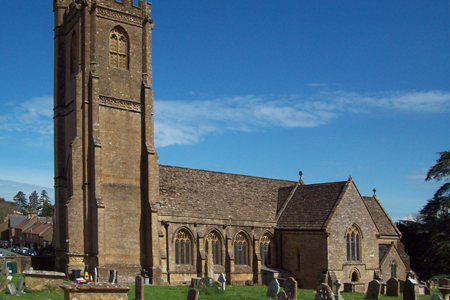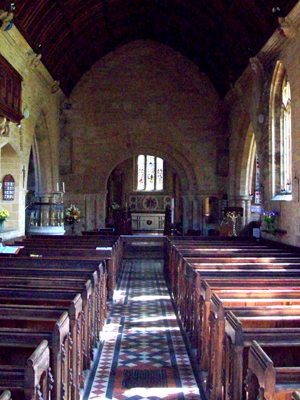| |
 |
 |
 |
| Comment on this report, or find other reports. |
 |
| Our Mystery Worshippers are volunteers who warm church pews for us around the world. If you'd like to become a Mystery Worshipper, start here. |
 |
| Find out how to reproduce this report in your church magazine or website. |
|
|
| 3007: St Catherine's, Montacute, England |
 |
 |
 |
Mystery Worshipper: Liddell and Scott.
The church: St Catherine's, Montacute, Somerset, England.
Denomination: Church of England, Diocese of Bath & Wells.
The building: An ancient village church, possibly of Norman foundation, but rebuilt in succeeding centuries and restored rather artfully but heavy-handedly by the Victorians. It boasts a fine Somerset-type tower with a peal of six bells dating from the 17th century and rehung in 1948. The nave features perpendicular windows. It was all built of the local hamstone, which is one of the loveliest building materials. Interestingly, the chancel and nave are out of alignment; the chancel faces the rising sun at Michaelmas, suggesting a prior dedication to St Michael. The building contains a splendid series of tombs and memorials to the Phelips family, the former owners of Montacute House, a large Elizabethan stately home, now in the care of the National Trust.
The church: They appear to have an active social life, with a very profitable annual church fete, lunches in the local hostelry, and a very friendly relationship with the local Baptist chapel, with whom they hold a joint service on the third Sunday of the month, alternating between the two churches. There is parish eucharist on the first and second Sundays, an informal family service on the fourth Sunday, and morning prayer on Mondays.
The neighbourhood: Montacute, in Somerset, derives its name from the Latin mons acutus, or steep hill, referring to a prominent local feature. Montacute House, in the village, is one of the chief attractions of the National Trust in the South West. The village itself is one of those South Somerset picture postcard villages, built of local hamstone with cottages with roses round the door, nestling under the Mons Acutus, on top of which is an 18th century folly tower dedicated to St Michael.
The cast: Music was performed by the Axe Vale String Quartet: Alexandra Ennis and Colin Rowlands, violins; Diana Rowlands, viola; and Caroline Lewars, cello. Readings were given by variouis members of the congregation, the churchwardens, the lay reader, and other lay members.
The date & time: Good Friday, 25 March 2016, 11.00am.
What was the name of the service?
A Meditation with Words and Music, including a performance of Haydn's Seven Last Words of Christ, op. 51.
How full was the building?
Three-quarters full in the nave, probably about seventy or more people present.
Did anyone welcome you personally?
Yes, a warm welcome from several people.
Was your pew comfortable?
A normal rather ugly pitch-pine pew.
All right for an hour, but not much more.
How would you describe the pre-service
atmosphere?
Very quietly chatty. This was not a liturgical service, and many had obviously come solely for the music.
What were the exact opening words of the
service?
"Good morning. Welcome to our reflection for Good Friday."
What books did the congregation use during the
service?
A printed order of words and music, containing all the readings and names of the musicians and readers.
What musical instruments were played?
Violin, viola, cello.
Did anything distract you?
I did not allow anything to distract me from the music or from the readings.

Was the worship stiff-upper-lip, happy clappy, or
what?
A formal music recital, treated as such. Haydn wrote his Seven Last Words of Christ in 1783 on commission from the Oratorio de la Santa Cueva in Cádiz, Spain. It was played as part of the Oratory's Good Friday service, which apparently was quite an elaborate affair. The work consists of seven slow movements preceded by an overture and a concluding "earthquake" movement. Haydn reworked the original orchestral version as a string quartet four years later, and as an oratorio with chorus some time after that. At today's service, the various movements of the piece were interspersed with readings, which consisted of passages from the Bible; Renaissance, Elizabethan and 20th century writings of Julian of Norwich, John Donne, Dylan Thomas and Robert Frost; and some anonymous pieces.
Exactly how long was the sermon?
There was no sermon. It would have required the likes of St John Chrysostom to improve upon the quality of the music and the readings. All the readers had obviously practised their parts; they were read faultlessly, without a stumble.
Which part of the service was like being in
heaven?
Everything.
And which part was like being in... er... the other place?
Knowing that no other church happening could begin to approach the heavenly quality of this one. Later in the day I attended a Good Friday service elsewhere – and I regret to say it was not anywhere near as meaningful or well prepared.
What happened when you hung around after the service looking lost?
There was quiet chat afterwards in the churchyard. I thanked the string quartet for their contribution to my Good Friday.
How would you describe the after-service
coffee?
There was none, and none was required.
How would you feel about making this church your regular (where 10 = ecstatic, 0 = terminal)?
10 – And then some! If every service were as carefully prepared as this, and as beautifully and thoughtfully presented with such reverence and devotion, churches throughout the land would be bursting at the seams. Unfortunately, such occasions are rare.
Did the service make you feel glad to be a
Christian?
Glad, humble, thankful, penitential – I can hardly enumerate all the thoughts and emotions stirred by this meditation. It shows what a small village church is able to do to make Good Friday an extraordinary and meaningful experience for a wide range of people.
What one thing will you remember about all this in seven days' time?
I will treasure having participated in this event for months, if not years to come. |
|
|
 |
 |
 |
| We rely on voluntary donations to stay online. If you're a regular visitor to Ship of Fools, please consider supporting us. |
 |
 |
 |
| The Mystery Pilgrim |
 |
| One of our most seasoned reporters makes the Camino pilgrimage to Santiago de Compostela in Spain. Read here. |
 |
 |
 |
| London churches |
 |
| Read reports from 70 London churches, visited by a small army of Mystery Worshippers on one single Sunday. Read here. |
| |
|
|
|
|


